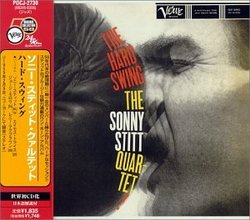"The Hard Swing" Swings Bop Best!
Zed | 02/14/2009
(5 out of 5 stars)
"Sonny Stit's music never gets old. A Bop Icon who stands the test of time. If you like jazz that shows-off what a master of sax can do ...this is for you. A real find!"
Sonny and Blue
Samuel Chell | Kenosha,, WI United States | 05/20/2009
(5 out of 5 stars)
"I'm convinced that when it comes to Sonny Stitt and Old Blue (Sinatra, for any come-latelies), it's totally impossible to go wrong with anything either performer recorded in the 1950s. In the '60s and '70s both artists would have their ups and downs, not simply as performers but in terms of venues, programs, producers, and orchestrators. But Sinatra on Capital during the '50s is simply never short of perfection, as is Stitt on Roost, Roulette, and Verve. If you need proof, look at the shared repertories of both performers during this time--American gold, the very best of the Songbook. And both artists had the distinction of making record sessions orchestrated by two of the most respected orchestrator-conductors in the business--Ralph Burns and Quincy Jones (which is not to say that either one was as well suited to Sinatra as were Nelson Riddle and Gordon Jenkins).
The other reason that both Sinatra and Stitt struggled in the '60s was (and here come the red flags and controversy) the abysmal material they had to work with. I'm sorry, but "Gentle on My Mind," "By the Time I Get to Phoenix," "Little Green Apples," and "For the Good Times" are representative of a culture in decline no less than the electronica and disco that would follow and the rap and hip-hop that would come next. As a pianist, I can't begin to express the disappointment I feel every time there's a request that any of these "songs" be played as instrumentals on an acoustic instrument. There's simply not enough there to work with--the melody is practically non-existent (dull and repetitious accompaniment for prosaic recitative). The pervasiveness of a rock n roll mentality and the dumbing down of much C&W music (haul out the semis, with literally tons of equipment, light shows and big amps in the service of the "people's music" and throw in a guitar and cowboy hat).
It's little wonder that the most recorded song by a wide margin is Johnny Green's "Body and Soul" with its multi-flatted chorus and multi-sharped bridge, giving any musician some real music to put his lessons and practicing to the test. And yet from the viewpoint of both Sonny Stitt and Art Tatum, they were playing "simple" music with the express purpose of entertaining the people. Little did they suspect how complex and inaccessible their "simple" would become compared to the public's.
This 1959 Verve session isn't necessarily Sonny's best, but it's sufficiently representative of his singular command of his instruments and his craft. The rhythm section of Amos Trice (piano), George Morrow (bass) and Lenny McBrowne (drums) is not the most distinguished, though Morrow was busy with Max Roach's groups and McBrowne was one of the "hardest" swingers though largely unacknowledged. It's unfortunate that it took until 2006 for the date to be reissued, and by a Japanese company at that; but even sorrier is the scarcity and exorbitant price of the item a mere two years after its release. Welcome to music, jazz, and the state of the art in America's new millennium.
(There are numerous other Stitt sessions that have the same songs, performed equally well if not better, and at a far more attractive price. If you're a musician, especially a saxophonist, you practically need Stitt's recordings to learn the songbook and to hear definitive interpretations. In that case, go to Mosaic Records and consider ordering one of the limited box editions comprising all of Sonny's Roost dates during this decade.)"


 Track Listings (11) - Disc #1
Track Listings (11) - Disc #1